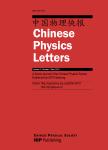X0(2900)and X1(2900):Hadronic Molecules or Compact Tetraquarks
X0(2900) and X1(2900):Hadronic Molecules or Compact Tetraquarks作者机构:School of PhysicsSoutheast UniversityNanjing 210094China School of PhysicsSun Yat-Sen UniversityGuangzhou 510275China School of PhysicsBeihang UniversityBeijing 100191China
出 版 物:《Chinese Physics Letters》 (中国物理快报(英文版))
年 卷 期:2020年第37卷第10期
页 面:12-16页
核心收录:
学科分类:07[理学] 0805[工学-材料科学与工程(可授工学、理学学位)] 070202[理学-粒子物理与原子核物理] 0704[理学-天文学] 0702[理学-物理学]
基 金:Supported by the National Natural Science Foundation of China(Grant Nos.11722540 and 12075019) the Fundamental Research Funds for the Central Universities
摘 要:Very recently the LHCb collaboration reported their observation of the first two fully open-flavor tetraquark states,the X 0(2900)of J P=0^+and the X 1(2900)of J P=1^−.We study their possible interpretations using the method of QCD sum rules,paying special attention to an interesting feature of this experiment that the higher resonance X 1(2900)has a width significantly larger than the lower one X 0(2900).Our results suggest that the X 0(2900)can be interpreted as the s-wave D∗−K∗+molecule state of J P=0^+,and the X 1(2900)can be interpreted as the p-wave¯c¯s u d compact tetraquark state of J P=1^−.Mass predictions of their bottom partners are also given.



